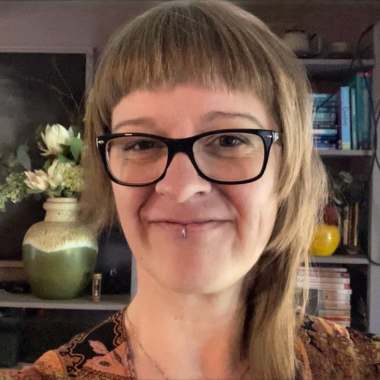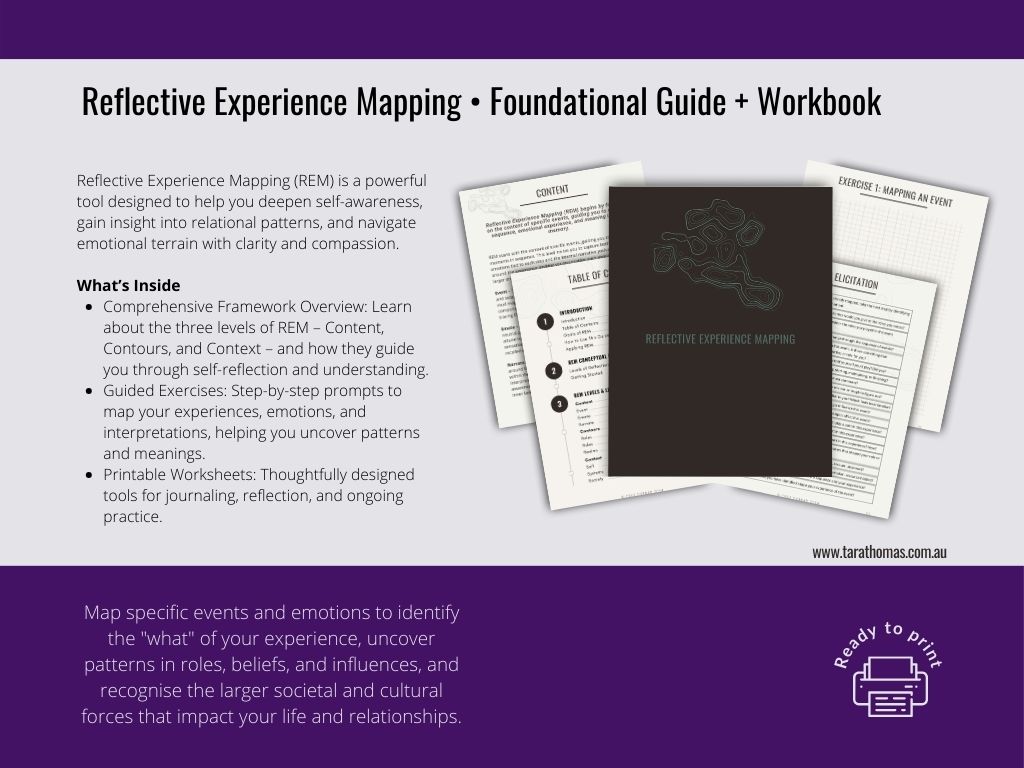Image by by pixelshot from Canva.

Image by by pixelshot from Canva.
Help! I’m Attracted to Someone Else: How to Handle Sexual Chemistry When You’re In a Relationship
Finding yourself sexually attracted to someone else while in a committed relationship can feel unsettling, but it’s more common than you might think so there’s no need to feel sad, bad, or weird! If you’re wondering “Why am I attracted to someone else?” you’re in the right place—I wrote this for you.
 How to Use This Blog
How to Use This Blog
This blog is designed a bit differently. Instead of giving you big ideas and saving the "how" for a product pitch at the end, I like to walk you through the process step-by-step—with practical tools you can actually use. Think of it like a workbook in blog form: hands-on, reflective, and designed to support real insight.
You’ll find:
-
Reflection prompts woven throughout, which you can sit with quietly or journal through—whatever suits your style
Exercises to guide you through specific steps, practices, or processes
-
Tools and worksheets to help you go deeper——some are free, some are paid
Reference sheets for quick, printable overviews of key ideas that go beyond what’s covered in the blog
-
Optional next steps at the end, if you'd like to work with me directly
You can dip in or dive deep. No need to “do it right”—the way you engage is the right way for right now. My goal is to make the ideas doable—not just understandable. (And if you’re overthinking that, hi. You’re among friends.)
Now, let’s get into WHAT sexual attraction actually is, and why it might be showing up the way it is for you.

Help! I’m Attracted to Someone Else: How to Handle Sexual Chemistry When You’re In a Relationship
Feel free to jump into any part that speaks to you—or just scroll down and keep going.
➤ Part 1: This post! Keep scrolling to get rolling


 What is Sexual Attraction?
What is Sexual Attraction?
Before we dive into doing the work, we need to pause and ask:
What’s actually happening when we feel attracted to someone else?
This might sound like your classic dry intro—“The dictionary defines attraction as...”
But it’s actually a core idea.
Because what if the real confusion isn’t about attraction—but how you’ve been taught to think about it?
This section is the what.
It gives you the groundwork:
-
What sexual attraction really is
-
Why it’s more layered than it seems
-
How culture, biology, psychology, and relationships all shape the experience
So let’s start with the basics, because most of us are never taught how complex this really is.
It’s Biopsychosocial (Stick With Me)
Being sexually attracted to someone else is a biopsychosocial experience…which is a dense academic way of saying that sexual attraction isn’t just about your body, it’s also about your mind and the broader influence of people & culture.
So, ‘bio’ is for biological stuff- like your physical health, hormones, and genetics.
‘Psycho’ is for psychological stuff – your thoughts, emotions, and how you see the world.
And ‘social’ (or sociocultural) is about your social context –relationships, your upbringing, and cultural norms & expectations.
That means it’s not as simple as thinking someone’s hot and wanting to hook up.
It's complex because there's a bunch of factors that create that experience for you.
If you’re finding it hard to unpack being attracted to someone else, understanding starts here. Understanding the what and the why of your attraction gives you the power to approach the how with more care and agency—instead of feeling helpless to chemistry.

 Social Myths About Sexual Attraction
Social Myths About Sexual Attraction
Humans are meaning-making machines, making sense of our experiences by creating narratives about what happens, why, and what it means. At best, those stories are incomplete or inaccurate . At worst, they're pure fantasy or confirm our deepest fears.
We all carry hidden rules about what attraction is supposed to mean—many of them absorbed without question.
They come from culture, media, religion, family, past relationships... and they shape our reactions before we even realise it.
This section is here to name some of those stories.
Not to shame them, but to help you see how much meaning might already be baked into the way you're thinking about this.
When you're attracted to someone else, the discomfort often stems from these attraction stories—what you believe it says about you, your relationship/s, or your life. Many of these narratives are rooted in patriarchal and mono-normative ideas about relationships, such as:
- Being sexually attracted to someone else is dangerous for your relationship/s.
- If I'm attracted to someone else, I should either cut them off or pursue them.
- Feeling sexual chemistry means I should question my current relationship/s.
- Flirting, fantasising, or being attracted to someone else is cheating.
- Spending time with someone I'm attracted to is an emotional affair.
- I'm attracted to someone else because my partner/s did or didn’t do something.
- If things were good in my relationship/s, I wouldn’t feel this way.
But this isn't limited to monogamy-
Faulty beliefs aren't exclusive to monogamy. Consensually non-monogamous (CNM) relationships also come with harmful myths, like:
- Open relationships mean I can flirt or sleep with anyone.
- I can do whatever I want, and if my partner is upset, it's because they're not "doing the work."
- If you’re in an open relationship, jealousy isn’t allowed.
- Feeling jealousy means I’m not ready for ethical non-monogamy.
- Asking for limits means I’m immature, needy, or controlling.
- Breaking agreements or hurting someone makes me toxic or manipulative.
- If you’re not attracted to others, you should be monogamous.
 Reflection Prompts
Reflection Prompts
Before you move on, take a moment to pause and check in with yourself.
-
Are there any beliefs in the list above that feel familiar—even if you’ve never said them out loud?
-
Which ones feel true to you, even if they also bring discomfort or confusion?
-
Where do you think those beliefs came from? (Think: your upbringing, past relationships, cultural messages, or media.)
-
How might those beliefs be shaping the way you’re thinking or feeling about this attraction?
You don’t have to have all the answers. Just recognising these myths can be a powerful step toward clarity and self-understanding. By seeking out information or support (like you’re doing right now!) you’re already taking an important step toward understanding your attraction story and working out how to move forward.
 FAQ about Sexual Attraction to Someone Else
FAQ about Sexual Attraction to Someone Else
Before we move into the process itself, I want to pause and name some of the most common questions people carry into this work.
These questions are completely understandable—and if you’re asking them, you’re not alone.
But as you’ll see, sometimes the question itself points to a deeper story underneath.
So let’s take a moment to slow those questions down and see what might be hiding inside them.
Is It Normal to Be Sexually Attracted to Someone Else While in a Relationship?
Does This Mean My Relationship is Over?
 Reflection Prompts
Reflection Prompts
Before you move on, take a moment to check in with your own story.
-
When you notice attraction to someone outside your relationship, what’s the first thing you tend to think or feel?
-
Do you find yourself asking, “Is this normal?” or “What does this mean?”
-
Where do you think those reactions come from—what messages have you absorbed about attraction, loyalty, or desire?
-
Is there any part of you that feels shame, confusion, or panic in response to your attraction? What do you think that’s about?
You don’t need to “fix” your reaction—just noticing it is a powerful step. This reflection isn’t about deciding what’s right or wrong. It’s about meeting yourself with honesty and curiosity, so you can make conscious choices that align with you, not outdated rules or unconscious fear.

Okay—this is where we switch gears.
The first half of this post was about giving you context: what attraction actually is, how social stories shape it, and why your questions might be more complicated than they seem.
Now we’re entering the second half of the process:
The part where we do something with all of that.
Let me start by saying: this part might piss you off.
(Or at least frustrate you a little.)
Most of the people I work with who are navigating attraction to someone else are caught in a loop of searching for answers. There’s a sense that if they could just understand the thing—how to stop being attracted—then they could finally solve their “problem.” All the stress and big feelings would dissolve.
Unfortunately, it rarely works that way.
If you’re like my favourite clients—intelligent, self-aware, and generally great at figuring things out—you’re probably here because your usual tools aren’t cutting it.
And I want to be really clear: that’s not a failure of your problem-solving skills.
It’s just that this isn’t a problem that comes from that realm.
And because you’re probably a deep thinker too, there’s a good chance you’ve already looped this through your head a dozen different ways—turning it over, trying to reason your way through.
But most of the time, people are searching for answers, not processes.
The hunger for clarity, the push for a fix, the discomfort of uncertainty—it’s all real.
And so is the shift that happens when we stop trying to logically “solve” something that needs to be felt into to be understood.
What actually works is a slower, more iterative approach—a kind of gentle unwinding.
You take each thread and look at it separately. It’s like untangling Christmas lights.
Sure, it’d be amazing if you could tug one magic strand and have the whole knot fall away.
But most of the time? It’s a slow, patient hand that gets you there.
So the goal here isn’t to rush toward answers—it’s to slow things down.
Enough to actually see what’s going on beneath the fizz and sparks,
so you can decide what you want—not just what your brain is trying to resolve, or what others think you should do.
 The Threads We’ll Follow
The Threads We’ll Follow
This is where the larger series begins.
Each part explores a different piece of your attraction story—so you can move through whatever part feels most relevant to you.
You don’t have to read it all.
You don’t have to go in order.
Just start with whatever feels most alive or intense right now.
Step 1- How to Stop Being Attracted (or Not—Let’s Unpack It)
This step is about slowing the collapse—separating what happened from what you felt, what you thought, and what you told yourself it meant.
You’re not trying to explain or justify anything yet.
You’re just walking back through the moment with curiosity and neutrality, so you can start to see what’s actually there.
If you’re thinking, “What is even happening?”—this is your starting point.
We’re going to slow everything way down. You’ll trace one specific moment of attraction through your body, your emotions, and the meaning you made of it—before the story fully formed.

 Want to Go Deeper? Try Reflecting Visually
Want to Go Deeper? Try Reflecting Visually
If Part 2 is your next stop, you might want a more intuitive, creative way to work through it.
That’s where the Creative Worksheets for Visual Reflection come in.
They’re designed to help you take this work out of your head and onto the page—whether that means sketching, mapping, or visually breaking down a moment you keep looping on.
These aren’t about “doing it right”—they’re about seeing your story in a new way.
Sometimes, changing the form is what helps you shift the frame.
Instead of overthinking, you start seeing what’s really going on.
Unpacking Your Attraction • Creative Worksheets for Visual Reflection
Looking for a more intuitive way to unpack your experience? These downloadable worksheets offer three creative formats—Comic Strip, Mind Map, and Mud Map—to help you slow down and lay out your experience through a different lens.
Whether you’re sketching key moments, mapping emotional patterns, or laying it out like a journey, these tools help you see your story more clearly—and work with it more tangibly.

Step 2 – Why Am I Attracted to Them? (And What Does It Say About Me?)
This step is about expanding the lens—zooming out from the moment itself to explore what might be shaping your attraction beneath the surface. Viewing your experience of being attracted to someone else from new perspectives can reveal hidden aspects and provide valuable insights.
If you’ve already slowed things down and unpacked a specific experience, this is where we start asking why this person, this moment, this intensity?
You’ll explore the roles you tend to play, the rules you’ve internalised, and the realms of experience that influence how attraction shows up for you—so you can see the difference between real connection and familiar pattern.
If you’re asking, “Why am I so drawn to this person?” or “What does this mean about me?”—start here.

 Desire or Dynamics: What Repeats—and Why It Matters
Desire or Dynamics: What Repeats—and Why It Matters
If those questions stirred something in you, you're not alone. Sometimes what we read as chemistry is actually a familiar dynamic playing out again—and recognising which pattern you're repeating can be a powerful turning point. That’s exactly what this next tool, the Relationship Roles: First Steps Workbook is designed to help you explore.
Ready to dive into dynamics? Download the workbook below
What if You’re Drawn to the Pattern, Not the Person?
Unexpected chemistry can feel overwhelming—especially in a committed relationship. But what if it’s not about this person, but a deeper pattern?
- Are you drawn to a familiar ‘type’ again and again?
- Do you unconsciously slip into the same role in relationships?
- Is this attraction about excitement—or escaping a pattern?
The Relationship Roles: First Steps Workbook brings new perspectives to how attraction and chemistry are shaped by relationship patterns.

Step 3 - Consider the Context
Consider the contextual elements of this attraction to someone else. It really fucking matters.
Attraction doesn’t exist in a vacuum. It’s shaped by who you are, the systems you engage with, and the society around you. These forces influence your experiences, perceptions, and even the choices available to you. By considering these broader contexts, you can gain clarity about your feelings and actions in a way that aligns with your values and circumstances.
How do your personal identities and lived experiences influence your feelings of being attracted to someone else? Reflect on aspects such as gender, culture, sexuality, neurodivergence, or past relationships.
- What draws you to this person?
Are they reflecting a part of yourself that you value—or perhaps a part you wish to explore or understand more deeply?
By examining the role of your identity in this attraction, you can uncover hidden layers of meaning and gain a clearer understanding of what’s truly driving your feelings.
2. Examine the Systems Around You
3. Uncover Societal Influences
 From Overthinking to Orientation: A Map for Complex Experiences
From Overthinking to Orientation: A Map for Complex Experiences
If you’ve been bouncing between “is it me?” and “is it everything?”—this is the framework that helps you hold both. Unlike the more focused tools, this workbook introduces the full REM system so you can walk through your experience layer by layer, without getting stuck in the same loops.
Ready to see the whole picture? Download the REM Workbook below
Need Help Seeing the Specific AND the Systemic?
The Reflective Experience Mapping Workbook introduces a practical, flexible framework for working through complex experiences.
You'll explore three levels of reflection—Content, Contours, and Context—using guided questions, mapping tools, and simple, repeatable structures. Whether you’re overwhelmed by emotion, stuck in overthinking, or questioning everything from your identity to your relationships, REM helps you move through it with curiosity, clarity, and care.
Step 4 - Make a Plan
This decision deserves to be made with love and clarity, not driven by fear or pressure.
Rather than reacting to the ups and downs of daily life—“They were late, so I should leave!” or “We had great sex, so I should stay!”—set aside intentional time to reflect on the bigger picture. What is the true potential of this attraction, and what are the long-term consequences of your choice? As Chade Fallstar wisely said:
“Don’t do what you can’t undo, until you’ve considered what you can’t do once you’ve done it.”
If you’re feeling attracted to someone else, but your relationship still feels worth investing in, focus on how you can address challenges or reconnect. This might include:
- Seeking therapy: Explore individual or couples therapy to identify and work through unresolved dynamics. I frequently work with individuals, couples, and polycules to navigate the complexities of an attraction to someone else in a way that is compassionate and meaningful. If this resonates with you, book a free Meet & Greet below to see if we’re a good fit to work together.
- Discussing with your partner: If your relationship is on the line, include your partner. It’s discourteous—and frankly uncool—to make a decision that affects both of you unilaterally. Honest communication can be challenging, but it’s an essential step toward understanding what’s right for both of you.
- Reinvigorating connection: Turn back towards your partner to nurture intimacy, rediscover shared goals, and rebuild the sense of partnership.
2. Consider Leaving
3. ¿Por Qué No Los Dos?

Step 5- Still Have Questions?
I’m so glad you’ve found your way here, especially if you’re navigating a situation that feels... complicated.
This guide, Help! I’m Attracted to Someone Else, reaches over 2500 readers every month. Many return more than once, which tells me how common (and quietly overwhelming) this experience can be.
But if you’ve landed here, read through, and still feel like something’s missing, you’re probably right.
Depending on what best aligns with your goals right now, there are a few different ways to take next steps:
-
Work through the reflections and exercises in this blog at your own pace. You don’t have to download anything or make a plan—just take your time moving through the questions already here.
-
Use the tools I've created to dive deeper. Throughout this blog, you’ll find links to supplemental worksheets, guides, and resources (look for the
tool icon). These are designed to help you explore your experience more tangibly and thoroughly.
-
Book a free Meet & Greet. Online advice can only go so far—it can’t always account for the unique nuances of YOUR circumstances. If you'd like personalised support, I work with individuals, couples+ and polycules to help unpack what's happening, how you're feeling, and what you're going to do. If you’re curious, the Meet & Greet (below) is an easy, no-pressure way for us to get vibes of whether we're a good fit!
 Optional Next Steps
Optional Next Steps
If your attraction to someone else has become intrusive, distressing, or otherwise unpleasant for you and/or your partner(s), exploring personal therapy or relationship therapy can be incredibly helpful. This isn’t a ploy to get you to work with me—it’s a reflection of years of experience showing how situations like these often unfold.
Many people wait until their feelings feel overwhelming before seeking support, but making sense of them sooner can prevent unnecessary stress and miscommunication. There’s no single “right” way to handle this—your approach will depend on your culture, family dynamics, lived experiences, identity intersections, and other contextual elements that shape who you are and how you navigate relationships.
- On one hand, this is a common relational experience, and when approached with sensitivity and care, it can lead to healthier, more connected relationships.
- On the other hand, avoiding or ignoring these feelings can create internal struggles that go beyond the relationship itself. Left unaddressed, attraction can become tangled with shame, confusion, and isolation, making it harder to trust your own emotions and intentions. Without a space to process, people often find themselves caught between suppressing feelings or acting on them impulsively—neither of which leads to real clarity.
Within a relationship, unspoken attraction can quietly shift dynamics over time. If it’s avoided, it may show up as distance, frustration, secrecy, or resentment which build up over time. These unprocessed emotions can create a backlog which is then the biggest obstacle in future couple(s) therapy, making it harder to focus on the actual issue(s)
 Book a Meet & Greet
Book a Meet & Greet
If you'd like to explore whether I'm a good fit as your sounding board & support, you can book a Meet & Greet directly into my calendar.
This saves the endless cycle of "sorry I took so long to reply to your email" and allows you to ask all the questions.
There's zero pressure to work with me, it's literally;
- getting a sense of what's happening (you tell me as much or as little as you like)
- explaining the logistics of the way I work
- asking questions (if you have any)

Australian Residents;
International Clients;



